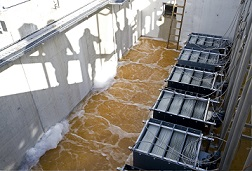
The new process is alternative to the established activated carbon/precipitation/sand filtration process and combines absorption of micro pollutants on activated carbon and membrane filtration.
Due to the high concentration of microorganisms and the contamination by antibiotics coming from animal breeding, hospitals and ambulant applications, elimination of micro pollutants in biologically treated wastewater is becoming more and more important.
At present, a combination of powdered activated carbon and subsequent sand filtration is mainly used to eliminate micro pollutants. Although this process can reduce trace substances like drug residues in the effluent of a wastewater treatment plant, the sand filter does not ensure complete separation of activated carbon particles so further treatment steps must be implemented.
In this new process, the membrane filtration step takes over the job of separating (powdered) activated carbon, micro plastics and (multi-resistant) germs. So it ensures not only compliance to threshold values for drug residues and other trace substances, but also ensures compliance to expected concentration limits for multi-resistant germs and micro plastic in effluents of wastewater treatment plants.
The BIO-CEL membrane module.





